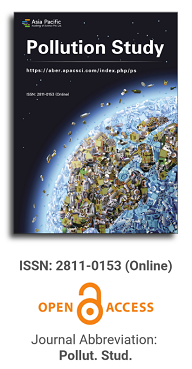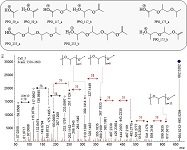
Asia Pacific Academy of Science Pte. Ltd. (APACSCI) specializes in international journal publishing. APACSCI adopts the open access publishing model and provides an important communication bridge for academic groups whose interest fields include engineering, technology, medicine, computer, mathematics, agriculture and forestry, and environment.

The (partial) replacement of synthetic polymers with bioplastics is due to increased production of conventional packaging plastics causing for severe environmental pollution with plastics waste. The bioplastics, however, represent complex mixtures of known and unknown (bio)polymers, fillers, plasticizers, stabilizers, flame retardant, pigments, antioxidants, hydrophobic polymers such as poly(lactic acid), polyethylene, polyesters, glycol, or poly(butylene succinate), and little is known of their chemical safety for both the environment and the human health. Polymerization reactions of bioplastics can produce no intentionally added chemicals to the bulk material, which could be toxic, as well. When polymers are used to food packing, then the latter chemicals could also migrate from the polymer to food. This fact compromises the safety for consumers, as well. The scarce data on chemical safety of bioplastics makes a gap in knowledge of their toxicity to humans and environment. Thus, development of exact analytical protocols for determining chemicals of bioplastics in environmental and food samples as well as packing polymers can only provide warrant for reliable conclusive evidence of their safety for both the human health and the environment. The task is compulsory according to legislation Directives valid to environmental protection, food control, and assessment of the risk to human health. The quantitative and structural determination of analytes is primary research task of analysis of polymers. The methods of mass spectrometry are fruitfully used for these purposes. Methodological development of exact analytical mass spectrometric tools for reliable structural analysis of bioplastics only guarantees their safety, efficacy, and quality to both humans and environment. This study, first, highlights innovative stochastic dynamics equations processing exactly mass spectrometric measurands and, thus, producing exact analyte quantification and 3D molecular and electronic structural analyses. There are determined synthetic polymers such as poly(ethylenglycol), poly(propylene glycol), and polyisoprene as well as biopolymers in bags for foodstuffs made from renewable cellulose and starch, and containing, in total within the 20,416–17,495 chemicals per sample of the composite biopolymers. Advantages of complementary employment in mass spectrometric methods and Fourier transform infrared spectroscopy is highlighted. The study utilizes ultra-high resolution electrospray ionization mass spectrometric and Fourier transform infrared spectroscopic data on biodegradable plastics bags for foodstuffs; high accuracy quantum chemical static methods, molecular dynamics; and chemometrics. There is achieved method performance |r| = 0.99981 determining poly(propylene glycol) in bag for foodstuff containing 20,416 species and using stochastic dynamics mass spectrometric formulas. The results highlight their great capability and applicability to the analytical science as well as relevance to both the fundamental research and to the industry.
Current state of environmental contamination in the Oaxacan Mixtec Region
Vol 5, Issue 1, 2024
Download PDF
Abstract
Objective: To present a systematic review of studies that evaluate the impact caused by urban solid waste generated in the Oaxacan Mixtec region. Results: The analysis of the research results consulted in the following databases: Red de Revistas Científicas de América Latina y el Caribe (Redalyc), Scientific Electronic Library Online (Scielo), Dialnet, EBSCO and Consorcio Nacional de Recursos de Información Científica y Tecnológica (CONRICYT), show that pollution is a problem that has been gradually increasing globally, which has led to the presence of foreign organisms and substances that interfere with and damage the health of people, natural resources and the ecological balance; It is worth mentioning that the impact on communities caused by the inadequate generation and management of solid waste significantly alters the ecosystem of the areas surrounding the disposal sites. It is important to note that there is legislation in this area that specifically classifies the different disposal sites and entrusts the municipalities with the integral management of urban solid waste, but this legislation is not correctly applied despite the fact that this problem has become very important in the last two decades in governmental spheres. Conclusions: Mexico faces the challenge of resolving environmental problems in order to reach a level of sustainability and sustainability in the medium term. The generation rates of urban solid waste continue to increase because we live in a society that has drastically modified its consumption habits. The degradation of the environment and natural resources for the Oaxacan Mixtec region is classified in ranges from unstable-critical to critical, causing pressure on natural resources, which is why we must have an adequate management and disposal of municipal solid waste, to achieve this it is necessary to have the support of society, governments and society in general, this synergy is necessary to reduce the extraction of resources used to produce them obtaining economic, social and environmental benefits in the long term for the region.
Keywords
References
- Gómez-López C, Barrón K, Moreno L. Economic growth and environment in Mexico. Available online: http://www.scielo.org.mx/scielo.php?script=sci_arttext&pid=S2448- 718X2011000300547&lng=en&tlng=en (accessed on 2 April 2024).
- Grossman GM, Krueger AB. Economic Growth and the Environment. The Quarterly Journal of Economics. 1995; 110(2): 353-377. doi: 10.2307/2118443
- Komen MHC, Gerking S, Folmer H. Income and environmental R&D: empirical evidence from OECD countries. Environment and Development Economics. 1997; 2(4): 505-515. doi: 10.1017/s1355770x97000272
- Montaño N, Sandoval A. Air pollution and health. Available online: http://www.redalyc.org/pdf/294/29406504.pdf (accessed on 2 April 2024).
- Ministry of Environment and Natural Resources. Report on the State of the Environment in Mexico. Ministry of Environment and Natural Resources. 2013.
- Gaviria C, Muñoz J, González G. Air pollution and vulnerability of exposed individuals: a case study for downtown Medellín. Available online: http://www.scielo.org.co/pdf/rfnsp/v30n3/v30n3a08.pdf (accessed on 2 April 2024).
- Ripple WJ, Wolf C, Newsome TM, et al. World Scientists’ Warning to Humanity: A Second Notice. BioScience. 2017; 67(12): 1026-1028. doi: 10.1093/biosci/bix125
- Gleick P. Water in crisis: a guide to the world's fresh water resources. Oxford University Press. 1993.
- World Health Organization (WHO). Drinking-water. Available online: https://www.who.int/en/news-room/fact-sheets/detail/drinking-water (accessed on 2 April 2024).
- Bain R, Cronk R, Hossain R, et al. Global assessment of exposure to faecal contamination through drinking water based on a systematic review. Tropical Medicine & International Health. 2014; 19(8): 917-927. doi: 10.1111/tmi.12334
- Ministry of Environment and Natural Resources (Semarnat). Report on the Situation of the Environment in Mexico. Available online: https://apps1.semarnat.gob.mx:8443/dgeia/informe15/tema/pdf/Informe15_completo.pdf (accessed on 2 April 2024).
- Riojas-Rodriguez H, Schilmann A, Lopez-Carrillo L, Finkelman J. Environmental health in Mexico: current situation and future perspectives. Available online: http://www.scielo.org.mx/scielo.php?script=sci_arttext&pid=S0036- 36342013001000013&lng=en&tlng=en (accessed on 2 April 2024).
- National Institute of Statistics and Geography (INEGI). Statistical Yearbook of the State of Oaxaca. National Institute of Statistics and Geography. 1993.
- Gobierno del Estado de Oaxaca. Available online: https://www.oaxaca.gob.mx/ (accessed on 2 April 2024).
- Berumen M. Mixtec Region. Socioeconomic Aspects and Proposals for Action for its Growth and Development Huajuapan de Leon (Spanish). Available online: http://www.eumed.net/cursecon/libreria/2004/mebb2/index2.htm (accessed on 2 April 2024).
- Terraciano K. The Mixtecs of colonial Oaxaca The ñudzahui history from the sixteenth to the eighteenth century. Mexico: Fondo de Cultura Económica; 2013.
- National Institute of Statistics and Geography (INEGI). Population and Housing Census 2010. Available online: https://www.inegi.org.mx/programas/ccpv/2010/default.html (accessed on 2 April 2024).
- Mindek D. Mixtecos. Available online: http://www.cdi.gob.mx/dmdocuments/mixtecos.pdf (accessed on 2 April 2024).
- Armella Spitalier Cultural Foundation. Mixtecs, People of rain. Available online: http://www.aglutinaeditores.com/media/resources/public/ae/ae1b/ae1b3fe0304d4c4bb9f cc8c1c1c8fba61b.pdf (accessed on 2 April 2024).
- Sierra A, Hernández J, Barba C. Autochthonous breeds of the Oaxacan Mixteca of Mexico. Archivos de zootecnia. Available online: http://www.uco.es/organiza/servicios/publica/az/php/img/web/05_13_31_67sierra3.pdf (accessed on 2 April 2024).
- Animal gourmet. Available online: https://www.animalgourmet.com/2015/10/21/un-paseo-por-el-paraiso- gastronomico-de-las-8-regiones-de-oaxaca/ (accessed on 2 April 2024).
- National Institute of Statistics and Geography. Statistical and Geographic Yearbook of Oaxaca 2016. Available online: http://www.diputados.gob.mx/sedia/biblio/usieg/mapas2016/Oax_mapas.pdf (accessed on 2 April 2024).
- García H. Considerations on municipal solid waste (MSW) landfills. Available online: https://www.ceddet.org/wp- content/themes/ceddet/pdf/revistas/residuos/n3_residuos.pdf (accessed on 2 April 2024).
- Ministry of Environment and Natural Resources (Semarnat). Soil degradation: area affected by processes, by state, according to levels of degradation. Available online: http://dgeiawf.semarnat.gob.mx:8080/ibi_apps/WFServlet?IBIF_ex=D3_SUELO03_03& IBIC_user=dgeia_mce&IBIC_pass=dgeia_mce&NOMBREENTIDAD=* (accessed on 2 April 2024).
- Ministry of Finance of the Government of Oaxaca. Oaxaca Regional Development Plans 2011-2016. Available online: https://www.finanzasoaxaca.gob.mx/pdf/planes/planes_regionales/2011- 2016/Mixteca.pdf (accessed on 2 April 2024).
- Government of the State of Oaxaca. Regions - Government of the State of Oaxaca. Available online: https://www.oaxaca.gob.mx/regiones/ (accessed on 2 April 2024).
- National Institute of Statistics and Geography (INEGI). Intercensal Survey 2015. Available online: https://www.inegi.org.mx/programas/intercensal/2015/ (accessed on 2 April 2024).
- Rivas M, Palerm J. Characterization of soil management and rainwater use in the Mixteca alta: jollas and cajete corn (Spanish). [PhD thesis]. Colegio de Postgraduados; 2009.
- Ojeda S, Lozano G, Quintero M, et al. Household solid waste generation by seasonal period: the case of a Mexican city. Available online: http://www.redisa.net/doc/artSim2008/gestion/A26.pdf (accessed on 2 April 2024).
- Inter-American Association of Sanitary and Environmental Engineering (AIDIS). International Development Research Center (IDRC). Available online: http://www.polis.org.br/uploads/933/933.pdf (accessed on 2 April 2024).
- Winchester WL. Sustainable human settlements development in Latin America and the Caribbean. Available online: https://repositorio.cepal.org/handle/11362/5635 (accessed on 2 April 2024).
- Inter-American Development Bank. Report of the Regional Assessment of Urban Solid Waste Management in Latin America and the Caribbean 2010. Available online: https://publications.iadb.org/en/regional-evaluation-urban-solid-waste-management- latin-america-and-caribbean-2010-report. (accessed on 2 April 2024).
- Guzmán M, Macías C. Municipal solid waste management: an anthropological approach. The case of San Luis Potosí, Mexico; 2012.
- Ministry of Environment, Energy and Sustainable Development. Executive Summary of the State Program for the Prevention and Integral Management of Urban Solid and Special Handling Waste in the State of Oaxaca (PEPGIRSUME) (Spanish). Ministry of Environment, Energy and Sustainable Development; 2017.
- General Law for the Prevention and Integral Management of Waste (LGPGIR). Available online: https://www.global-regulation.com/translation/mexico/560306/general-law-for-the-prevention-and-integral-management-of-wastes.html (accessed on 2 April 2024).
- Wehenpohl G, Heredia P, Hernández C, de Buen B. Compliance Guide for NOM- 083-SEMARNAT2003,1nd ed. 2004. Available online: https://www.profepa.gob.mx/innovaportal/file/1306/1/nom-083-semarnat-2003.pdf (accessed on 2 April 2024).
- Ministry of Environment and Natural Resources (Semarnat). Urban Solid Waste Environmental Statistics (Spanish). Available online: http://www.semarnat.gob.mx/temas/estadisticas-ambientales (accessed on 2 April 2024).
- Ministry of Environment and Natural Resources (Semarnat). Urban Solid and Special Handling Waste (Spanish). Ministry of Environment and Natural Resources. 2017.
- Ochoa O. Collection and final disposal of solid waste, metropolitan area. Case: Ciudad Bolivar; 2009.
- Sáez AGU, Joheni A. Solid waste management in Latin America and the Caribbean. Available online: https://www.redalyc.org/pdf/737/73737091009.pdf (accessed on 2 April 2024).
- Vanegas Carvajal EA, Zuleta Salas GL. Conscientious objection to euthanasia: a personalist bioethical analysis for the Colombian case (Spanish). Revista Lasallista de Investigación. 2018; 15(1): 159-165. doi: 10.22507/rli.v15n1a6
- National Planning Department and World Bank. National Infrastructure Strategy. Solid Waste Sector; 2015.
- Ministry of Environment and Natural Resources (Semarnat). Draft amendment to Mexican official standard nom-083-semarnat-2003 (Spanish). Available online: http://dof.gob.mx/nota_to_doc.php?codnota=5402726 (accessed on 2 April 2024).
- Ministry of Environment and Natural Resources (Semarnat). Sites of final disposal of urban solid waste reported by municipality. Available online: http://dgeiawf.semarnat.gob.mx:8080/ibi_apps/WFServlet?IBIF_ex=D3_RSM01_11&IBI C_user=dgeia_mce&IBIC_pass=dgeia_mce&NOMBREENTIDAD=*&NOMBREANIO=* (accessed on 2 April 2024).
- Ministry of Environment and Natural Resources (Semarnat). Basic Diagnosis for Integrated Waste Management. Available online: http://biblioteca.semarnat.gob.mx/Documentos/Ciga/libros2009/CD001408.pdf (accessed on 2 April 2024).
- Aguilar A, López M, Santa María D. Situation and management of solid waste, Huajuapan de León, Oaxaca. Available online: http://www.eumed.net/rev/cccss/13/alsm.html (accessed on 2 April 2024).
- Risso W, Grimberg E, Ubal W. Guidelines for the integrated and sustainable management of municipal solid waste in Latin America and the Caribbean. Available online: https://idl-bnc-idrc.dspacedirect.org/handle/10625/34177 (accessed on 2 April 2024).
- Aguilar R, Valiente Y, Oliver D, et al. Inadequate use of solid waste and its impact on environmental pollution. SCIÉNDO. 2018; 21(4): 401-407. doi: 10.17268/sciendo.2018.044
- Grupo Mesófilo AC. Community Land Use Planning Study in san miguel el grande, Tlaxiaco, Oaxaca. Available online: http://www.grupomesofilo.org/pdf/proyectos/OTC/OTC_San_Miguel_Grande.pdf (accessed on 2 April 2024).
Supporting Agencies
Copyright (c) 2024 Marco Antonio Ruiz Vicente

This work is licensed under a Creative Commons Attribution 4.0 International License.

This site is licensed under a Creative Commons Attribution 4.0 International License (CC BY 4.0).
.jpg)
Beijing University of Technology, China



